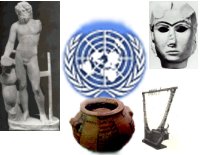Saturday, January 17, 2004

The Spoils of War: The Antiquities Trade and the Looting of Iraq, by Gregory Elich was posted on UNobserver.com on January 5, 2004.
It contains details of the looting at the Iraqi National Museum and Iraqi artifact recovery updates that I’ve read nowhere else.
Sadly, I did not see any updated information about the reportedly damaged Golden Harp of Ur.
In its conclusion, the UNobserver.com report said:
The destruction continues unabated with the exception of the few sites that were put under guard…occupation authorities have refused to issue arms to the guards. Unarmed and usually alone, there is little a guard can do to dissuade criminal gangs. "Sometimes the looters come by the hundreds," explains Thabit Gassad al-Fatlawi, head of Iraqi government inspections in southern Iraq.
The report contains an excellent primer on the antiquities trade and the mysterious, well connected and and media invisible American Council on Cultural Policy, a group representing collectors and dealers in Middle Eastern antiquities.
One of several posts about the ACCP appeared in this space on April 16, 2003.
There are several posts of interest at this link including a listing of the ACCP board members in the post dated October 28, 2003.
There was no mention of reported FBI, Homeland Security and Treasury involvement in the ongoing artifact recovery process despite this illuminating passage:
Well-organized professional thieves systematically looted the choice artifacts. Staff members intervening to save the most valuable objects were told they would be killed if they persisted. Witnesses reported seeing well-dressed men walking through the galleries talking into walkie-talkies or cell phones. One museum official claimed that two "European-looking" men entered the museum, pointed out individual objects, and then left. Artifacts were removed and hauled away in convoys of vans. "It is true that definitely some of the looters were very organized," says archaeologist Francis Deblauwe. "They even brought equipment to lift some of the heavier pieces.
Also, glass cutters were found of a type that’s not readily available in Iraq." Gil Stein, Professor of Archaeology at the University of Chicago, felt that it appeared that unscrupulous art dealers had placed orders in advance. "They were looking for very specific artifacts. They knew where to look." Claud-Peter Haase, Director of the Islamic Museum in Berlin, commented, "The people who did this knew precisely where the most priceless treasures were kept. They sought out certain objects, tracking them down and zeroing in on them as though they had a shopping list and a floor plan of the museum. It is also noteworthy just how these people were able to break into vaults and safes. These people were professionals and definitely knew what they were doing."
The Art Newspaper has the Homeland Security angle and reports a development that coincidentally benifits a certain dealer/collector lobbying group:
Agents who had concentrated exclusively on tracking and seizing smuggled art have now been redeployed to investigate cases related to the war on terrorism and financial fraud.
Although cases of stolen art will still be investigated by Customs agents, no employees will work exclusively on art investigations. The re-organisation has not been publicised, but government officials confirmed the move to The Art Newspaper
The normally staid Art Newspaper candidly goes on to say:
One critic of a conspiratorial bent hinted that aggressive investigators aggravated enough influential collectors and dealers in New York for them to lobby privately for the redeployment of the art squad: “When they finally saw the opportunity with the Bush administration’s new war on terror, they made a few phone calls to people in high places and took care of it”. The Art Newspaper has no evidence of such lobbying.
Images: UNobserver.com, The art Newspaper, Reuters

